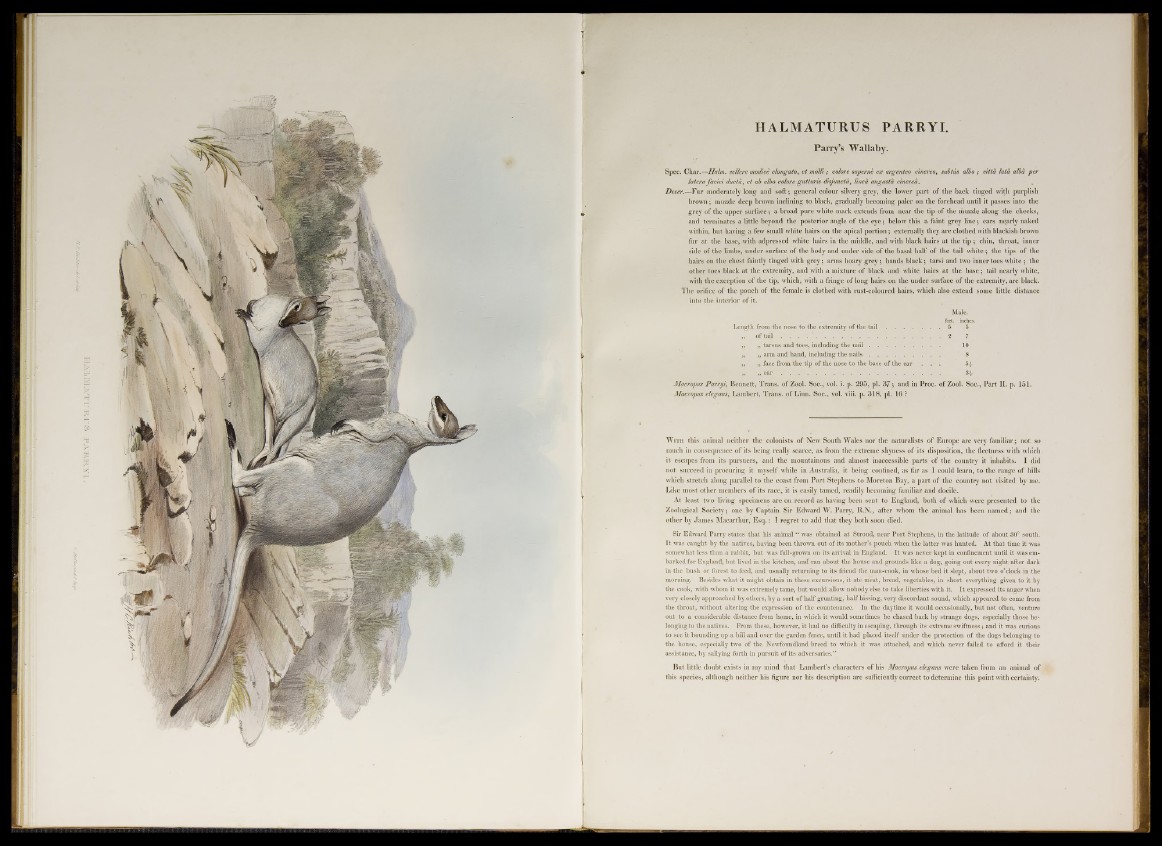
TULMMVdL S U ’M lU XVM T rV H
HALMATURUS PARRYI.
Parry’s Wallaby.
Spec. Char.—Halm, veliere modicè elongato, et mòlli ; colore superne ex argenteo cinereo, subtùs albo ,• città lata alba per
luterà faciei ductà, et ab albo colore gutluris dìsjunctà, linea angusta cinerea.
Descr.—Fur moderately long and soft; general colour silvery grey, the lower part o f the back tinged with purplish
brown ; muzzle deep brown inclining to black, gradually becoming paler on the forehead until it passes into the
grey o f the upper surface ; a broad pure white mark extends from near the tip o f the muzzle along the cheeks,
and terminates a little beyond the posterior angle o f the eye ; below this a faint grey line ; ears nearly naked
within, but having a few small white hairs on the apical portion ; externally they are clothed with blackish brown
fur at the base, with adpressed white hairs in the middle, and with black hairs at the tip ; chin, throat, inner
side o f the limbs, under surface o f the body and under side o f the basal half o f the tail white ; the tips o f the
hairs on the chest faintly tinged with grey ; arms hoary grey ; hands black ; tarsi and two inner toes white ; the
other toes black at the extremity, and with a mixture o f black and white hairs at the base ; tail nearly white,
with the exception of the tip, which, with a fringe o f long hairs on the under surface o f the extremity, are black.
The orifice of the pouch o f the female is clothed with rust-coloured hairs, which also extend some little distance
into the interior of it.
Male.
feet, inches.
Length from the nose to the extremity of the t a i l 5 5
„ of tail . . . . *................................................................................... 2 7
„ „ tarsus and toes, including the n a i l ............................................ 10
,, ,, arm and hand, including the nails ....................................... 8
,, „ face from the tip of the nose to the base of the ear . . - . 54-
| „ e a r .................................................................................................. 3£
Macropus Parryi, Bennett, Trans, o f Zool. Soc., vol. i. p. 295, pi. 3 7 ; and in Proc. o f Zool. Soc., Part II. p. 151.
Macropus elegans, Lambert, Trans, of Linn. Soc., vol. viii. p. 318, pi. 16 ? '
W i t h this animal neither the colonists o f New South Wales nor the naturalists of Europe are very familiar; not so
much in consequence o f its being really scarce, as from the extreme shyness o f its disposition, the fleetness with which
it escapes from its pursuers, and the mountainous and almost inaccessible parts o f the country it inhabits. I did
not succeed in procuring it myself while in Australia, it being confined, as far as I could learn, to the range o f hills
which stretch along parallel to the coast from Port Stephens to Moreton Bay, a part o f the country not visited by me.
Like most other members o f its race, it is easily tamed, readily becoming familiar and docile.
At least two living specimens are on record as having been sent to England, both o f which were presented to the
Zoological Society; one by Captain Sir Edward W. Parry, R.N., after whom the animal has been named; and the
other by James Macarthur, Esq.: I regret to add that they both soon died.
Sir Edward Parry states that his animal “ was obtained at Stroud, near Port Stephens, in the latitude of about 30° south.
It was caught by the natives, having been thrown out of its mother’s pouch when the latter was hunted. At that time it was
somewhat less than a rabbit, but was full-grown on its arrival in England. It was never kept in confinement until it was embarked
for England, but lived in the kitchen, and ran about, the house and grounds like a dog, going out every night after dark
in the bush or forest to feed, and usually returning to its friend the man-cook, in whose bed it slept, about two o’clock in the
morning. Besides what it might obtain in these excursions, it ate meat, bread, vegetables, in short everything given to it by
the cook, with whom it was extremely tame, but would allow nobody else to take liberties with it. It expressed its anger when
very closely approached by others, by a sort of half grunting, half hissing, very discordant sound, which appeared to come from
the throat, without altering the expression of the countenance. In the daytime it would occasionally, but not often, venture
out to a considerable distance from home, in which it would sometimes be chased back by strange dogs, especially those belonging
to the natives. From these, however, it had no difficulty in escaping, through its extreme swiftness; and it was curious
to see it bounding up a hill and over the garden fence, until it had placed itself under the protection of the dogs belonging to
the house, especially two of the Newfoundland breed to which it was attached, and which never failed to afford it their
assistance, by sallying forth in pursuit of its adversaries.”
But little doubt exists in my mind that Lambert’s characters of his Macropus elegans were taken from an animal of
this species, although neither his figure nor his description are sufficiently correct to determine this point with certainty.